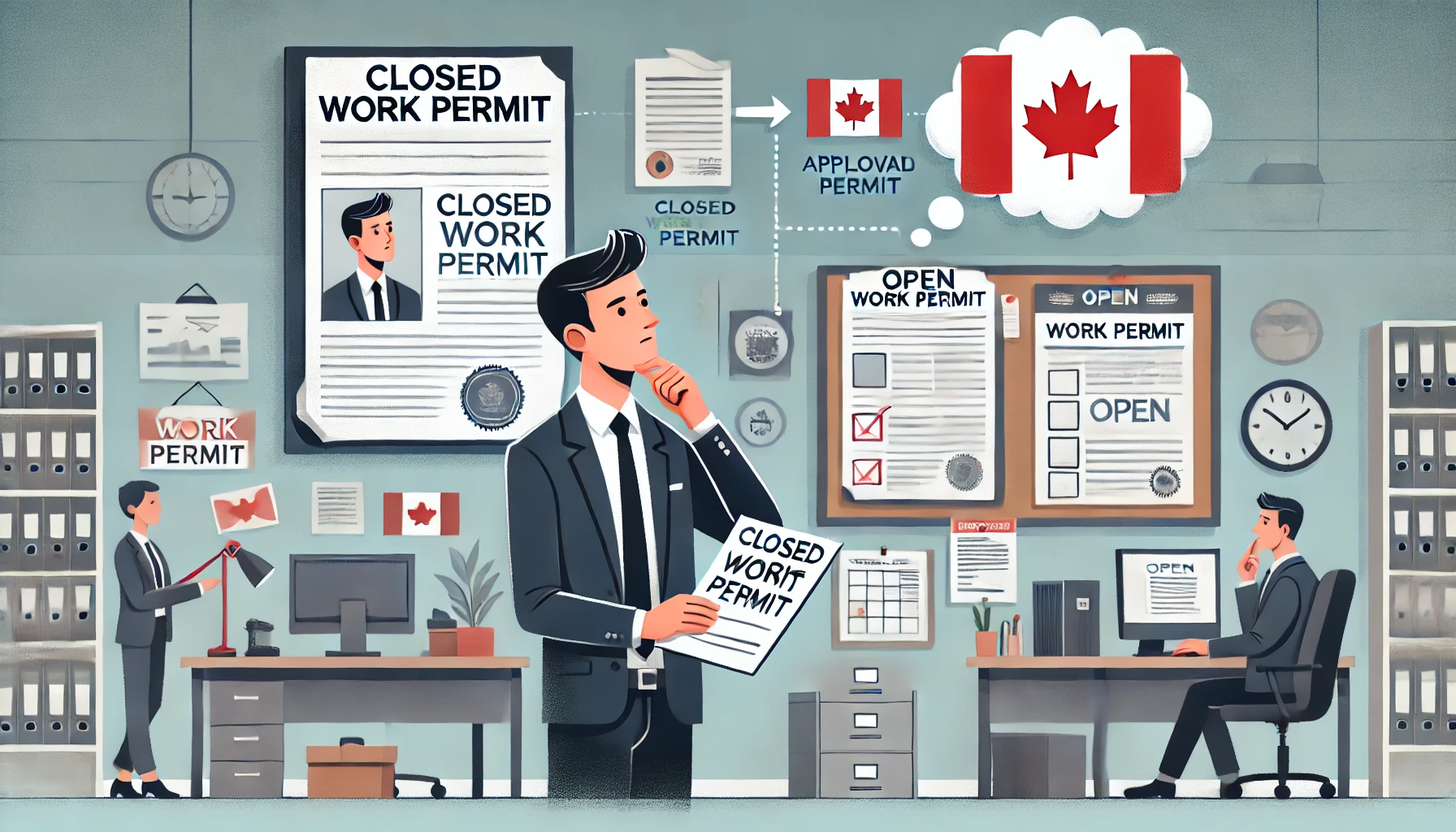Canada is a popular destination for skilled workers and professionals from around the world. With its strong economy, high quality of life, and diverse culture, it offers numerous opportunities for those seeking to work and live in the country. However, navigating the work permit system can be complex, especially when it comes to understanding the differences between closed and open work permits and the process of transitioning from one to the other.
Understanding Work Permits in Canada
Closed Work Permit
A closed work permit, also known as an employer-specific work permit, restricts the holder to working for a specific employer, in a specific job, and sometimes in a specific location. This type of permit is usually tied to a Labour Market Impact Assessment (LMIA), which is a document that an employer in Canada may need to get before hiring a foreign worker. The LMIA process ensures that hiring a foreign worker will not negatively impact the Canadian labor market.
Key Features of a Closed Work Permit:
- Tied to a single employer.
- Requires a job offer.
- May be location-specific.
- Usually requires an LMIA.
Open Work Permit
An open work permit, on the other hand, allows the holder to work for any employer in Canada, with some exceptions. It is not job-specific and does not require an LMIA or a job offer at the time of application. Open work permits are often issued under special programs or circumstances, such as the Post-Graduation Work Permit (PGWP) for international students or as part of family reunification programs.
Key Features of an Open Work Permit:
- Not tied to a specific employer.
- No job offer required at the time of application.
- More flexibility in terms of employment.
- Can work in different locations across Canada.
Why Transition from a Closed to an Open Work Permit?
Transitioning from a closed to an open work permit offers several advantages:
- Flexibility: An open work permit allows you to switch jobs or employers without needing to go through the application process again.
- Broader Opportunities: You can explore different job opportunities across various industries and regions in Canada.
- Reduced Risk: If you lose your job or wish to leave your current employer, an open work permit allows you to seek new employment without the constraints of a closed permit.
- Work-Life Balance: With an open work permit, you can take on part-time work or multiple jobs to better manage your work-life balance and financial stability.
Eligibility Criteria for an Open Work Permit
To be eligible for an open work permit, you must meet specific criteria depending on the program or category under which you are applying. Here are some common scenarios where you might qualify for an open work permit:
Post-Graduation Work Permit (PGWP)
- You must have completed a program of study at a designated learning institution (DLI) in Canada.
- The program should be at least 8 months long.
- You must apply within 180 days of receiving confirmation that you have completed your program.
Spousal Open Work Permit
- You are the spouse or common-law partner of a skilled worker in Canada.
- You are the spouse or common-law partner of an international student in Canada.
- You are the spouse or common-law partner of a Canadian citizen or permanent resident who has applied for spousal sponsorship.
Bridging Open Work Permit (BOWP)
- You have applied for permanent residence under an eligible program.
- Your current work permit is expiring within four months.
- You are currently in Canada and meet the other eligibility requirements.
Vulnerable Worker Open Work Permit
- You are experiencing abuse or are at risk of abuse in relation to your job in Canada.
Steps to Change from a Closed Work Permit to an Open Work Permit
Changing from a closed work permit to an open work permit involves several steps. Here’s a detailed guide on how to navigate the process:
1. Determine Your Eligibility
Before you start the application process, ensure that you meet the eligibility criteria for an open work permit under the relevant program. Review the requirements and gather the necessary documents to support your application.
2. Prepare Your Application
The application process may vary depending on the specific open work permit you are applying for. However, the general steps are as follows:
a. Gather Required Documents
- Proof of Status: Documents that prove your current status in Canada (e.g., your closed work permit).
- Proof of Eligibility: Documents that support your eligibility for the open work permit (e.g., completion of a study program, marriage certificate, job offer letter, etc.).
- Application Forms: Complete the necessary application forms, which can be found on the Immigration, Refugees and Citizenship Canada (IRCC) website.
b. Create an Online Account
Create an online account on the IRCC website. This account will be used to submit your application, track its status, and receive updates from IRCC.
c. Complete the Application
Fill out the application forms accurately and completely. Ensure that all required information and supporting documents are included. Double-check for any errors or omissions.
d. Pay the Fees
Pay the required application fees. The fee amount may vary depending on the type of open work permit you are applying for. Payment can typically be made online through the IRCC website.
e. Submit the Application
Submit your completed application and supporting documents through your online account. Keep a copy of the application and payment receipt for your records.
3. Wait for Processing
Once you have submitted your application, it will be reviewed by IRCC. Processing times may vary depending on the type of open work permit and the volume of applications. You can check the current processing times on the IRCC website.
4. Receive a Decision
IRCC will notify you of their decision through your online account. If your application is approved, you will receive your open work permit. If additional information or documents are required, IRCC will contact you with further instructions.
Common Challenges and How to Overcome Them
Transitioning from a closed work permit to an open work permit can come with its own set of challenges. Here are some common issues you might face and tips on how to address them:
1. Meeting Eligibility Criteria
Ensuring that you meet the specific eligibility criteria for the open work permit program you are applying for is crucial. Carefully review the requirements and gather all necessary documents to support your application. If you are unsure about your eligibility, consider consulting with an immigration consultant or lawyer.
2. Providing Complete and Accurate Information
Incomplete or inaccurate information can delay the processing of your application or result in a rejection. Double-check all forms and documents before submitting your application. Ensure that all information provided is accurate and up-to-date.
3. Understanding Processing Times
Processing times for work permit applications can vary. It is important to be aware of the current processing times and plan accordingly. Check the IRCC website regularly for updates on processing times and any potential delays.
4. Managing Application Fees
Application fees for work permits can be significant. Ensure that you are aware of the total cost and have the necessary funds available. Keep a record of all payments made and retain your receipts for reference.
5. Navigating Changes in Immigration Policy
Immigration policies and regulations can change, which may impact your application process. Stay informed about any updates or changes to immigration policies by regularly checking the IRCC website and other reliable sources.
Case Study: Transitioning from a Closed Work Permit to an Open Work Permit
Background
John, a software developer from India, moved to Canada on a closed work permit tied to a specific employer in Toronto. After working for a year, he realized that he wanted more flexibility to explore job opportunities in different cities and industries. John decided to apply for an open work permit through the Post-Graduation Work Permit (PGWP) program, as he had recently completed a postgraduate diploma at a designated learning institution in Canada.
Application Process
John gathered all the necessary documents, including his proof of status, completion letter from his educational institution, and application forms. He created an online account on the IRCC website, completed the application, and paid the required fees. John submitted his application and monitored its status through his online account.
Outcome
After a few weeks, John received a notification from IRCC that his application had been approved. He was issued an open work permit, allowing him to work for any employer in Canada. John was now free to explore new job opportunities and advance his career in Canada without the constraints of a closed work permit.
Conclusion
Changing from a closed work permit to an open work permit in Canada offers numerous benefits, including increased flexibility, broader job opportunities, and reduced risk. Understanding the eligibility criteria, preparing a complete and accurate application, and staying informed about immigration policies are key to a successful transition.
Whether you are an international student, a skilled worker, or a spouse of a Canadian citizen, an open work permit can open doors to new possibilities and enhance your experience in Canada. By following the steps outlined in this guide and addressing common challenges, you can navigate the process with confidence and achieve your career goals in Canada.





